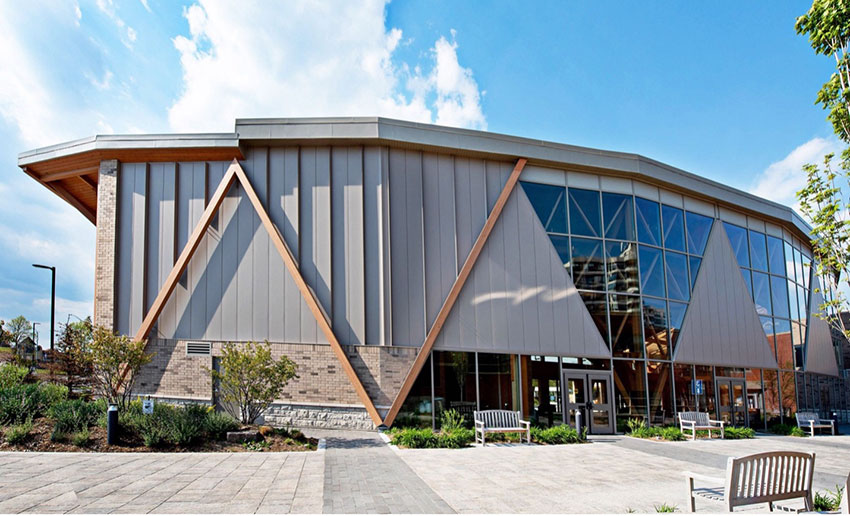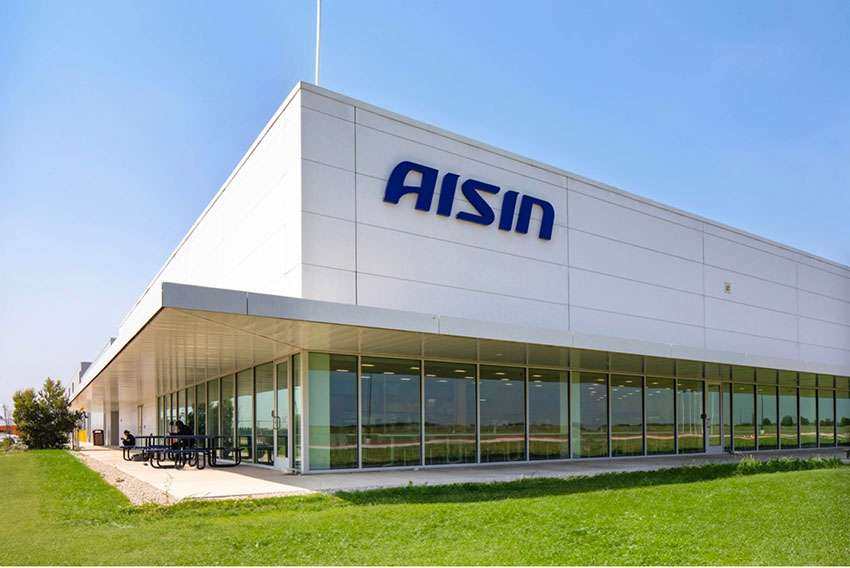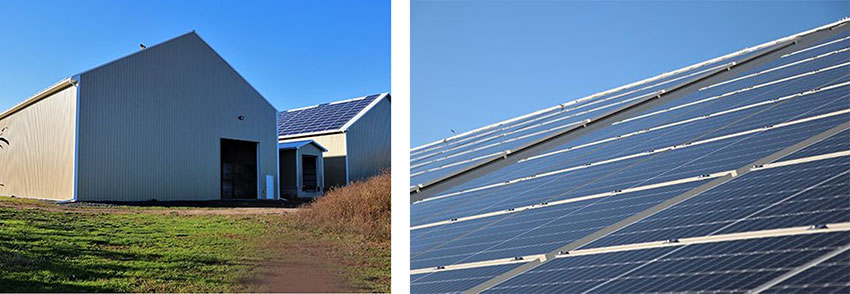This course is part of the Metal Architecture Academy
Building envelope material selections that improve building performance enable the design of a building to not only meet today’s code criteria, but also to satisfy the demands of the future. The innovations of insulated metal panels (IMPs) compare very favorably against traditional material systems. Durability, thermal performance, and energy efficiencies are a gain when using IMPs versus a system such as tilt-up concrete. Practically, using IMPs allows for simpler, safer, and cost-efficient installation and maintenance for a building. Advances in IMP technology also offer benefits for aesthetics. Selecting IMPs for a project offers a great opportunity to earn sustainable certifications, provide material health and transparency documentation, and avoid the negative environmental consequences of construction.
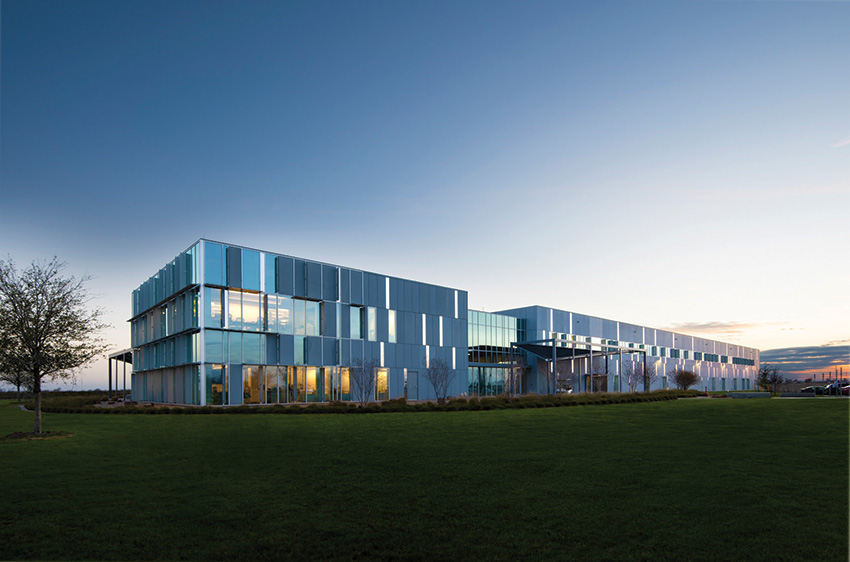
Photo courtesy of Kingspan Insulated Panels
With only six months to complete the DynaEnergetics building in Blum, Texas, architects avoided having to install multiple wall components, and instead were able to install the facade, insulation, and interior walls at the same time with only one installer by using insulated metal panels, saving time and staying within budget.
DEFINING IMPS
Breaking out beyond its traditional applications, architects and building owners are taking advantage of insulated metal panels’ growing architectural options, aesthetics, structural integrity, energy efficiency, light weight, and low maintenance for a wide variety of projects. As insulated metal panels move into a space traditionally dominated by tilt-up–a method of construction where large concrete panels are cast on site and then raised into position with a crane–how do their material characteristics and performance stack up for the modern building?
Meet the IMP
Insulated Metal Panels (IMPs) offer complete, lightweight enclosure systems for exterior walls and roofs. The panels combine metal skins and an insulating foam core. First developed by the National Aeronautics and Space Administration (NASA)1, these panels have superior insulating properties and their outstanding spanning capabilities and one-pass installation make them quick to install, providing unit cost savings when compared to other wall assemblies.
To deliver high-performance insulation, foam is injected, or poured, in place between two layers of metal skin. The insulation undergoes a chemical reaction, causing it to expand and bond to the metal skins, completely filling the interior cavity between the metal skins. The result is a factory-delivered, solid panel system that provides superior thermal value and resists moisture, insect, and rodent infiltration.
The most commonly used metal substrates for IMP faces are G90 galvanized steel or aluminum-zinc-coated steel, while some custom panels are made from stainless steel or aluminum. Architects are able to specify various panel insulation values, span lengths, and load/span capabilities.
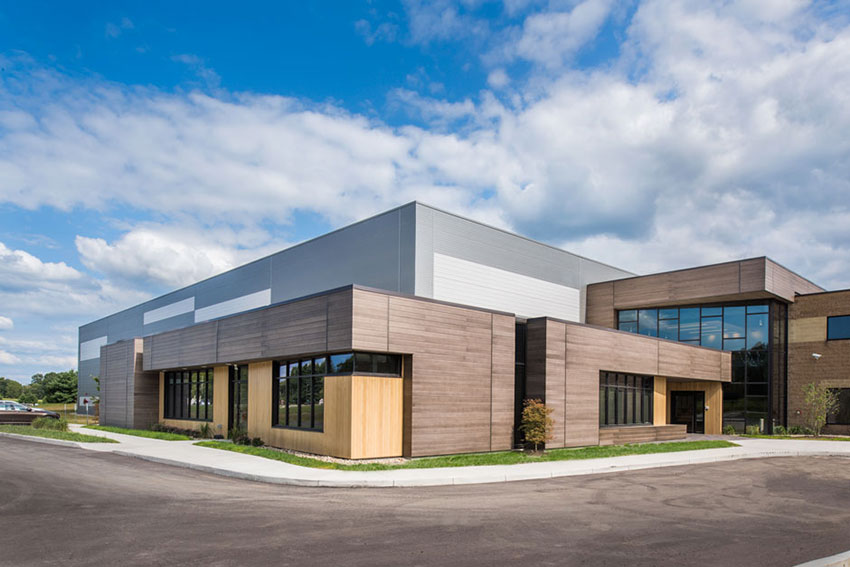
Photo courtesy of Nucor Insulated Panel Group
IMPs provide temperature control for the Sima & Sons office and cold storage facility in Ravenna, Ohio. IMPs are exposed on the interior and function as the interior cooler walls, which allowed for simple, one-time wall installation for both interior and exterior.
IMPs are available in a wide variety of colors, widths, profiles, and finishes. “The realization of virtually any design for walls and roofs is possible,” says RC Antal, Director of Insulated Metal Panels for ATAS International. IMPs deliver profiled options: designers can choose walls that are ribbed, fluted, or planked. For flat walls, finishes can be flat, textured, or striated. Entire panels can also be curved and formed. Additional design features include joint reveal widths, formed corner panels, end folds and treatments, heavier gauge flat facings, and integrated windows and louver systems. IMPs are available in a variety of high-performance coatings. Another offered finish feature is embossing, which creates surface texture on metal coils.
For the interior, a typical finish is a standard polyester 0.8 millimeter─including the primer─in a light-reflective and easy-to-maintain color. United States Department of Agriculture (USDA)-compliant finishes and stainless steel also are available for required applications, such as food processing and storage.
In the field, IMPs are not only considered as the primary exterior finish, but now also are designed as the primary building envelope. Additionally, their enclosures can be clad with various secondary rainscreen materials, such as brick veneer.
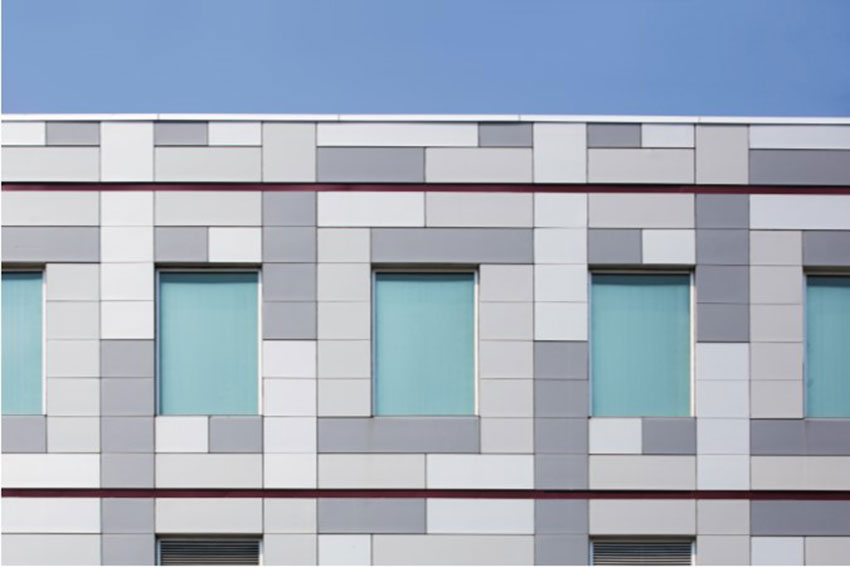
Photo courtesy of Kingspan Insulated Panels
Multiple colors, sizes and patterns of Insulated Metal Panels create a striking look for this warehouse, retail and commercial building in Brooklyn, New York. Patterns like this are not available with tilt-up, a form of precast construction.
Where They’re Found
IMPs are used in virtually every building type, from offices and warehouses to healthcare facilities, manufacturing centers, transportation, education, and recreational buildings.
- Commercial and Industrial: IMPs are ideal for all types of commercial and industrial buildings including institutional, recreational, and government buildings, and manufacturing facilities. Projects from schools to retail centers to power plants benefit from the energy efficient insulation, lightweight construction, durability, and cost-effective, timely installation of single-component IMPs. IMPs also provide solutions for a variety of climate considerations, including temperature, humidity, airborne particles, and air movement.
- Architectural: Architectural IMPs have the normal attributes of those used in commercial and industrial builds, such as high insulation values, speed of build, and vertical and horizontal applications. Additionally, architectural IMPs include options such as custom shapes and widths, special custom colors and finishes, and custom fabrication, including, but not limited to, factory-bended corners, curved panels, and trimless ends. Architectural IMPs offer options that can incorporate panels that coalesce with windows, louvers, sunshades, or other integrated products to offer total building envelope solutions. Their flexibility provides architects the freedom to create unique building designs.
- Cold Storage: Insulated Metal Panels are considered the ultimate solution for climate-controlled facilities. Whether the need is for manufacturing, processing, storage, or distribution of perishable food or other materials, an IMP wall can meet the demands. Available in panel thicknesses from 2-6 inches, a wall can be designed to meet multiple specific thermal performance requirements. Additional features include the panel’s long-spanning capability, flat and ribbed-shaped panels, high-performance coatings, as well as special joint designs and details to meet safe hygiene and contamination requirements.
Insulated Roofs
IMPs form a high-performance roofing solution that offers exceptional thermal performance, unparalleled ease-of-installation, and gives the designer freedom to create building profiles rich in character. As a roofing material, IMPs provide the highest level of insulation, simplest maintenance, and longest life, coupled with the quickest installation for low- and high-rise commercial and industrial roofing applications. The two-step installation process limits worker exposure to accidents and reduces the number of steps and materials required. These factors increase the speed of installation and slash schedule downtime while providing a roof with superior insulation properties that can last more than four decades.

Photo courtesy of Kingspan Insulated Panels
IMPs provided the best thermal envelope and reduced thermal bridging for this building at Portland Community College in Portland, Oregon, contributing to the building’s LEED certification.
IMPs and the Building Enclosure
Selecting IMPs means delivering a fully integrated solution for the building enclosure, as the panels arrive on site providing a full vapor and water barrier and continuous insulation. “IMPs are star performers, delivering four control layers all in one panel,” says Antal.
IMPs provide all four control layers within a single component, meaning they do not require the use of supplemental air, water, vapor, or thermal control layers. IMPs provide a “Perfect Wall” due to the location of their control layers. Water, air, and vapor control layers are all located on the exterior of the structure, with thermal control located outboard of the other control layers. This creates optimal enclosure performance and limits issues that can plague buildings, like moisture accumulation or air transfer. Because of this construction, IMPs can be used and expected to perform in all climate zones: cold, mixed, hot, humid, dry, or marine. IMPs also work for the demands of all interior environments: office, commercial, residential, institutional, pools, museums, art galleries, and data processing centers. Depending on climate zone and special requirements, IMPs can be used with supplemental cavity insulation subject to ratios listed in the International Building Code.
IMPs can also be used as a rainscreen barrier wall system and can be integrated with other wall and roof systems while still maintaining proper control layer continuity. Because of their inherent performance, IMPs offer a streamlined choice to meet the growing body of code requirements, including safety, fire, sustainability, performance, and building health. IMPs also meet or exceed multiple sustainable design criteria that contribute toward a project earning green building certifications.
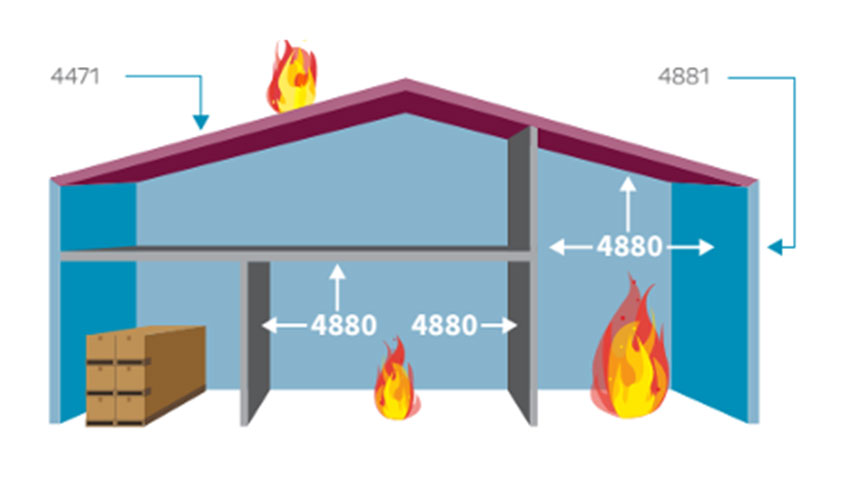
Photo courtesy of Kingspan Insulated Panels
An enhanced focus on verifying fire performance of all individual components, and components joined together as a system, has made U.S. fire testing regulations some of the most stringent.
Guaranteeing Performance: Understanding Codes and IMPs
Placing a product in a building means betting the future of the structure on that product’s performance. IMPs are subject to Chapter 26 International Building Code (IBC) requirements, including the 4471 approval standard for roofs (fire and uplift), the 4880 approval standard for walls and roofs (fire only), and the 4881 approval standard for exterior walls (fire and structural). As a metal composite material, IMPs are also governed by Chapter 14, NFPA 285 Standard Fire Test Method for Evaluation of Fire Propagation Characteristics of Exterior Wall Assemblies Containing Combustible Components. Preventing fire, and keeping any fire damage to a minimum, is a primary industry and regulatory concern. U.S. codes require that a fire test incorporates every one of the components of the wall assembly, just as the product is to be used in the field, instead of testing individual components only.
Although foam has fallen under the intense scrutiny of U.S. building codes, the scrutiny has paid off with safety. The use of IMPs containing foam plastic insulating materials, when they comply with the appropriate fire test requirements for both the components individually and the assembly itself, have been shown to exhibit excellent fire performance.
Engineering safety factors are determined by building codes, industry practices, general engineering principles, or ICC-ES Acceptance Criteria. For IMPs, overall panel strength is determined by the following laboratory tests:
- ASTM E72 -10 – Standard Test Methods of Conducting Strength Tests of Panels for Building Construction, and/or
- ASTM E330 – E330M-14 –Standard Test Method for Structural Performance of Exterior Windows, Doors, Skylights and Curtain Walls by Uniform Static Air Pressure Difference.
When an IMP panel meets required certifications and codes, that means the entire assembly has been put to the test. Everything from the metal facings and metal gauge’s thickness and tensile and yield properties; to foam core properties, including cohesion (how well foam sticks to itself when pulled apart), compression (how well foam holds up under pressure), and adhesion (how well foam sticks to metal skins); to panel design (joint engagement –male/female interlock depth, joint strength –geometry of male/female interlock, width of panels –distance between side joints, thickness –distance between skins); and finally, to attachment methods (clip strength, clip fit and placement within joint, load bearing area of clip, pullout strength of fasteners, pullout resistance of structural supports) is analyzed.

Photo courtesy of Kingspan Insulated Panels
This multi-tenant, mixed-use building on a prominent corner in Vaughan, Ontario, features insulated metal panels in dark bronze which complement the wooden panels.
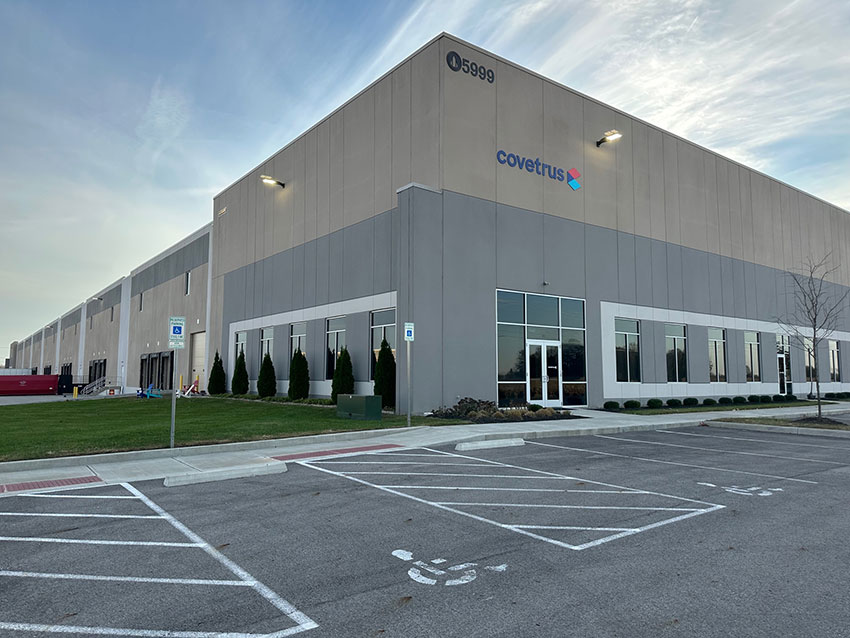
Photo courtesy of Metal Construction Association’s IMP Alliance
This building was built with precast, or tilt-up, construction, which requires a two-step installation process: large concrete panels are cast on site, which are placed in position by a crane.
The Competition: Tilt-Up Concrete
Tilt-up is a method of enclosure construction that uses large concrete panels, cast on site, that are raised into position with a crane. Concrete tilt-up products are a popular solution because of their general availability, durability, and fire resistance.
Constructing a tilt-up enclosure is a two-step process. First, the slabs of concrete that will form load-bearing sections of a building envelope or elevation, are cast horizontally on a concrete slab-on-ground. These slabs, referred to as panels, are tilted up with a crane after the concrete has reached necessary strength. The crane then sets the panels on prepared foundations. The designed wall line is formed from a series of these panels.
The American Concrete Institute (ACI) publishes concrete codes as well as guide and report documents. Under ACI 318 and the IBC, tilt-up is regarded as a form of precast construction. ACI 551.1R offers further guidance and description for tilt-up techniques.
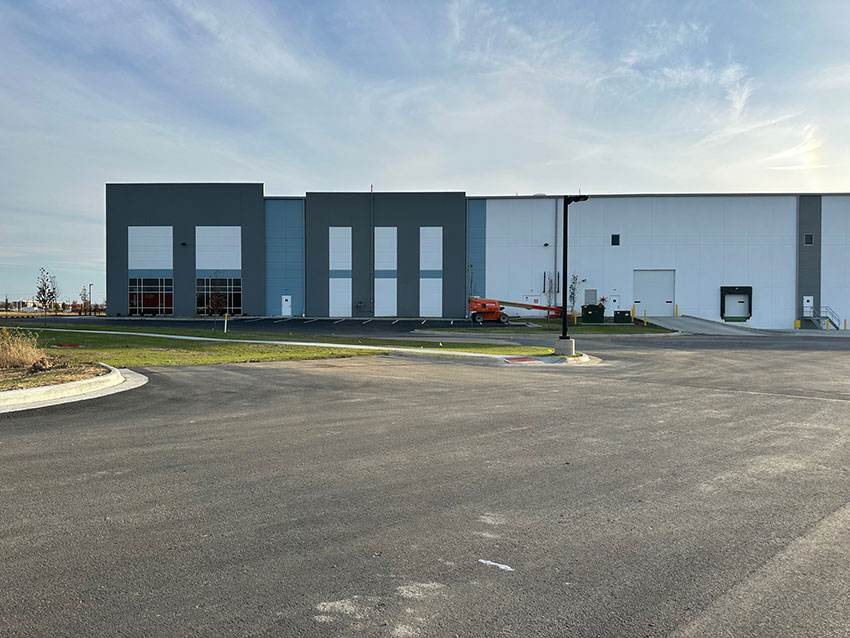
Photo courtesy of Metal Construction Association’s IMP Alliance
This concrete tilt-up building was limited to solid colors. The paint has no long-term warranties.
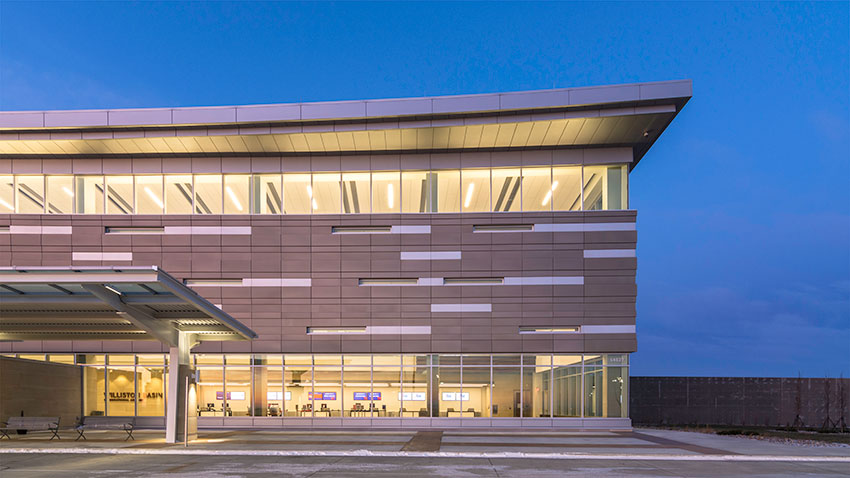
Photo courtesy of Kingspan Insulated Panels and Nucor Insulated Panel Group; Brennan Photo + Video
The Williston Basin International Airport in North Dakota is clad with insulated metal panels in an award-winning design.
Decision Point: IMPs and Tilt-Up
Aesthetics
For concrete tilt-up applications, options are limited to solid colors, which are field applied. The paint has low to medium durability, with no long-term warranties. As the colors and finishes are generated in the field, controls are not exact.
IMPs offer long-lasting, durable finishes generated in a controlled environment. The panels have finish warranties of up to 35 years or more, and can use PVDF (Kynar), FEVE (Fluoropolymer based), SMP (silicone modified polyester), Polyester, and Plastisol finishes. Standard 1.0 mil and high build systems offer different finishes, including mica, metallic, weathered metal, wood grain, and prismatic. Long-lasting, low-maintenance paint finishes in a multitude of colors provide design flexibility.
Tilt-up concrete can offer a range of textured finishes. Aesthetic options vary from smooth to exposed aggregate to plank finishes. IMPs offer both smooth and stucco finishes. However, tilt-up wall profiles are more difficult to create in the field. Precast offers greater flexibility, but IMPs are a natural fit where a specific profile is desired. The roll forming manufacturing process allows for greater creative expression, making IMPs the most practical solution to profile.
Both IMPs and tilt-ups are capable of ornamentation and additional product integration. They can also both accommodate curved wall construction.
IMPS IN THE FIELD
Insulated metal panels (IMPs) are one of only a few types of building product that can provide an entire building enclosure in one prefabricated product. An insulated metal panel system can be used on its own to provide a complete enclosure, can be added over a lightweight structure and interior finish in new construction, or can be added over an existing enclosure to provide a new level of enclosure performance.
Initial Advantages: Cost and Installation
Insulated metal roof and wall panels can save costs in materials and labor, due to their single-unit composition and quick installation. “They effectively replace complicated, multi-component assemblies,” says Lisa Fischer, marketing manager at Kingspan. Preformed metal panels are typically lower in installed cost than those of tilt-up, precast, or brick. That's because metal panels can often be installed faster than other building materials, resulting in construction cost savings. Because of their reduced comparative weight, IMPs systems can also save money by lessening structural steel requirements, since less support structure is needed. IMPs arrive on site with built-in thermal breaks, continuous insulation creating high R-values, and connecting panel interlocks, all in a single-element format allowing for faster installation.
Insulated metal panels can be installed more quickly because their installation is also not dictated by weather conditions. This all-weather capability minimizes construction delays, permits fast-track scheduling, gets the building dried-in more quickly, and allows the other trades to proceed with their interior work. Ease of handling and transportation, enhanced job site coordination, and single crew and trade coordination all speed the experience.
Average labor and material unit costs for tilt-up are between $80 and $100 per square foot for a core and shell project. IMPs total from $35 to $55 per square foot for a complete system.
IMP Installation Notes
Panel fabrication and installation are critical components for a successful project. It is imperative that IMPs have good alignment and follow tolerances, especially for those panels with minimal profiles. “Spend time reviewing the structure before erection of the panels,” recommends Arnold Corban, Kingspan. Manufacturer provided installation drawings should always take precedence over generic installation guides. Drawings give guidance for the unique conditions on the project.
The best fabrication will not satisfy the customer if the installation does not match that same level of quality. Guidelines to govern installation tolerances, which establish acceptable visual quality for preformed metal installations, look like the following:
- Panels and trim shall be installed true to line and level (if horizontal) or plumb (if vertical). Exposed fasteners shall be installed in straight lines and at the locations shown on the approved drawings.
- Field measurements to check tolerances shall be by means of commercially available squares, tape measures, or levels that are in good working condition. Measurements shall be made with panels positioned without restraint (if checking fabrication tolerances) and with sufficient support to prevent significant distortion or deflection.
- Panels should be progressively installed so that overall misalignment or tolerance issues are not focused on a single panel on the wall.
IMPs provide exceptionally strong building enclosures. It is not uncommon for these panels to successfully achieve spans of 10 feet or more between supports. For structural support, the width and thickness of the panels or the support spacing can be adjusted. The gauge of the metal facings can affect spanning capability, resistance to thermal stress, and flexural buckling. The composite bond of IMPs produces a building unit that is much stronger than the individual components, even with very light gauge facings. IMPs are not classified as “load-bearing” panels in the sense of axial loading. They can be used on a load-bearing wall, but only if the axial load is carried by other construction─not by the panels. Many insulated panels have a progressive tongue-and-groove interlock joint, being hard-fastened to the structure only along their leading edge. These side joint fastened panels can exhibit low resistance to racking type loads.
Ongoing Advantages: Maintenance and Flexibility
Besides first costs, costs that accrue over the life of a product should also be taken into account when determining full costs. With IMP products, ongoing maintenance costs are reduced as a result of continuing improvements in paints and coatings. Finishes will not crack or peel, which significantly reduces the potential of water penetration while increasing finish performance and weather integrity. IMPs require less maintenance than other exterior systems. Today’s IMPs retain their luster for decades, ensuring that the building maintains its aesthetic appeal and its property value for the long term. This longevity makes a difference when it comes time to sell the building. Facilities clad with IMP or metal composite material (MCM) systems retain their curb appeal and never look dated, often reducing the need for pre-sale refurbishing costs.
IMPs also facilitate easy renovations and building enhancements. The panels are flexible and can adapt to structural retrofits, accommodating new layouts or additions. They also can be easily disassembled for reuse.
Decision Point: IMPs and Tilt-Up
Fabrication and installation time combined is comparable between IMPs and tilt-up. However, IMPs arrive on site factory finished and prepared to act as a fully functioning enclosure. They also cost less. IMPs are less subject to weather delays than tilt-up.
As a retrofit solution, IMPs excel, given their light weight and design flexibility.

Photo courtesy of Kingspan Insulated Panels
IMPs created with a sustainable manufacturing process have lower embodied carbon and reduce operational carbon for years to come with high thermal efficiency, helping Caledon Industrial Park in Caledon, Ontario, on its quest to achieve LEED Silver certification.

Photo courtesy of Kingspan Insulated Panels
Vaultra Storage, clad with insulated metal panels, brings a modern, stylish vibe to the busy streets of Toronto, offering more than 2,100 climate-controlled storage units to customers.
IMPS IMPACT ON THE BUILDING
Insulated metal panels can fulfill all the required air, thermal, and water control functions to create a high-performing building enclosure. Designing with IMPs means realizing buildings with more consistent thermal properties and increased occupant comfort.
Insulating Capabilities of IMPs
Keeping the outside out and maintaining the comfort inside is the fundamental job of the building envelope. The ANSI/ASHRAE/IES Standard 90.1: Energy Standard for Buildings Except Low-Rise Residential Buildings shows a clear trend for continuous insulation, specifically in Zones 5, 6, 7, and 8. Continuous insulation is the best method to improve thermal performance. Properly installed, it increases the effective R-value of the wall system. Continuous insulation additionally blocks thermal bridging–heat transfer–created by common types of exterior wall construction.
As a turnkey option, delivering a full vapor and water barrier–along with continuous insulation–IMPs are an easy way to meet growing code requirements, says Cassie Robertson, preconstruction manager, DPR Construction. IMPs generally use a foamed-in-place or polyisocyanurate foam plastic insulation, at thicknesses of 2-4 inches, achieving R-values in place of up to 45. This type of material can provide a thermal resistance value (R-value) of 7 per inch (nom.), compared to values of between 2 to 4 for fiberglass or mineral wool. High R-values are a driving reason behind the popularity of foam plastic insulation materials.
Supplementary insulation may be added to IMPs based upon a WUFI analysis, which evaluates the action of heat and moisture in walls, to meet other specified requirements. WUFI is a computer program that can tell how moisture and heat flow affect building materials over time. Insulated metal panel systems, by virtue of their joint geometry address thermal bridging in a more robust manner than typical “site built” assemblies for walls and roof, a design asset for maintaining thermal performance. Thermal bridging occurs when there is a break in a building’s insulation, so it is important to carefully consider the joint detailing when selecting a system.
Water and Air Barrier Capabilities of IMPs
The most important non-structural and non-fire performance aspect of any wall system is its ability to control rainwater. Historically, a widely used method of controlling rainwater was to install claddings over insulated metal panel systems, providing a continuous water control layer coupled with a continuous drained air gap over this water control layer. Because of its successful history of past performance in rainscreen applications, IMPs are widely recognized for their water- and air-barrier capabilities.
Two major ASTM standards are used to evaluate air and water performance of IMP wall assemblies: ASTM E28 -04(2012) Standard Test Method for Determining Rate of Air Leakage Through Exterior Windows, Curtain Walls, and Doors Under Specified Pressure Differences Across the Specimen and ASTM E331-00(2009) Standard Test Method for Water Penetration of Exterior Windows, Skylights, Doors, and Curtain Walls by Uniform Static Air Pressure Difference. The following ASTM standards are used to evaluate air and water performance of IMP roof assemblies: ASTM E1680-11 Standard Test Method for Rate of Air Leakage Through Exterior Metal Roof Panel Systems (Specialized adaptation of E283) and ASTM E1646-95 (2011) Standard Test Method for Water Penetration of Exterior Metal Roof Panel Systems by Uniform Static Air Pressure Difference (Specialized adaptation of E331).
To best leverage the insulating and water and air barrier capabilities of insulated metal panel systems, it is important to pay close attention to how the system interfaces holistically. Paul Collyer, Vice President of Business Development, Cornerstone Building Brands, Denver, Colorado, emphasizes that, when dealing with any type of barrier wall, it is important to maintain continuity of control layers–specifically air, vapor, water, and thermal. “Proper details showing how the barrier system should interface with penetrations, material transitions, etc. are critical to proper envelope performance,” Collyer says.
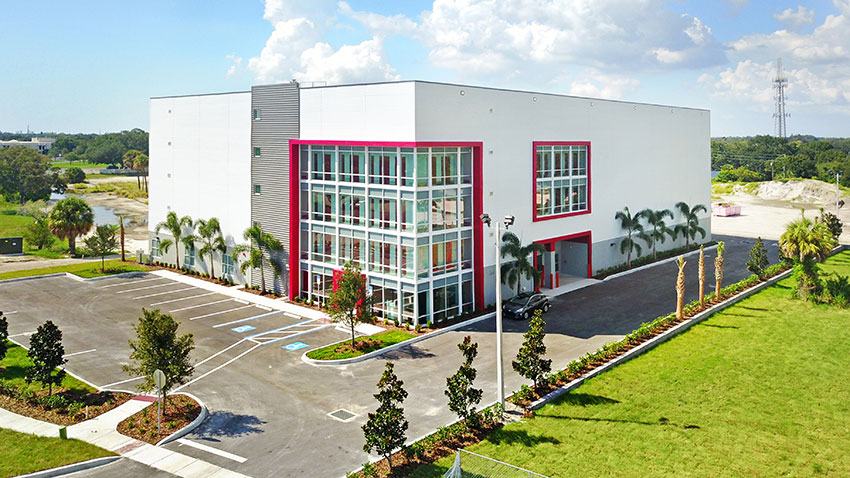
Photo courtesy of Metal Construction Association
This five-story, 100,000-square-foot, Class A self-storage facility in St. Petersburg, Florida, was clad with IMPs. The thermal benefits from IMPs help keep the building cool in the Florida heat.
IMPs and Tilt-Up
Envelope Performance
Insulated metal panels (IMPs) are one of only a few types of building product that can provide an entire building enclosure in one prefabricated product. IMPs and tilt-ups with added cavity insulation both provide excellent liquid water management. While the use of concrete also provides some thermal mass for a building, IMPs provide superior thermal resistance, with an in-place R-value of up to 45. IMPs are also impervious to water. There is no loss of performance due to sagging or compression with IMPs, and a virtual elimination of thermal bridging.
IMPs provide superior air infiltration performance and vapor diffusion management. This can also be achieved with tilt-up structures, but only after sandwich and cavity systems are installed.
Tilt-up and pre-cast concrete panels require no modifications for fire resistance. IMPs are suitable for all construction types when used in accordance with the International Building Code (IBC). Of note, however, is the performance of IMPs in high wind load areas and seismic areas. Here, IMPs offer superior reliability and disaster resistance over tilt-up.
IMPS AND SUSTAINABILITY
As an advanced engineered material, the steel behind IMPs is the material of choice for engineers and architects because of its strong performance characteristics, durability, reliability, versatility in design, and consistency as a product.
While certain natural materials, like wood, may appear to have a more favorable CO2e profile, this can be misleading as all impacts should be considered in responsible material selection. It is also important to consider the effect of service life on this analysis. A structure which lasts half as long as another should be considered as having twice the impact for comparison purposes. With many green advantages over other materials, metal can reduce energy consumption, improve air quality and thermal comfort, help comply with energy codes, and minimize environmental impacts. Steel lasts longer, requires less maintenance, and is completely recyclable, unlike many other construction products. Pioneering new production methods that include manufacturing steel from green hydrogen have helped to further reduce embodied carbon content of certain insulated metal panel products by up to 25 percent.
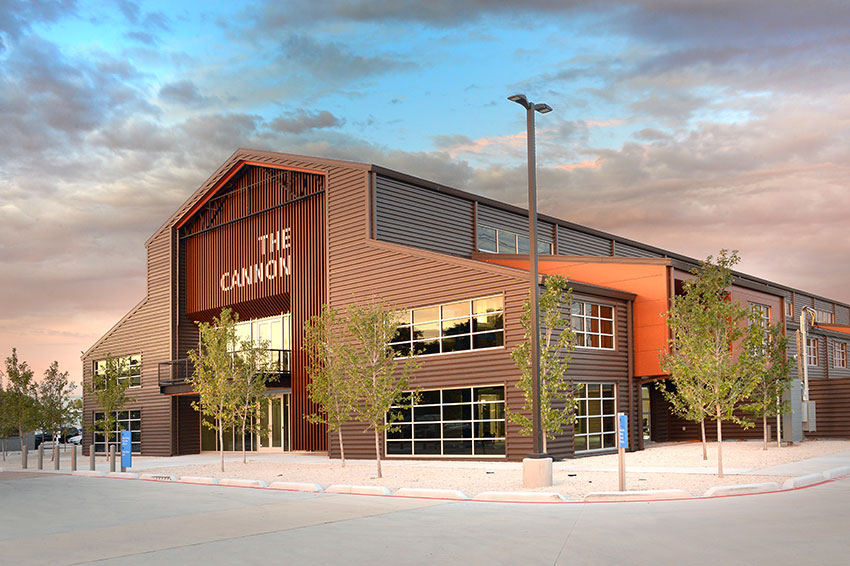
Photo courtesy of Nucor Insulated Panels Group
The Cannon, an entrepreneurial hub in Houston, Texas, called for more than 90,000 square feet of insulated metal panels (IMPs) for walls and roofing.
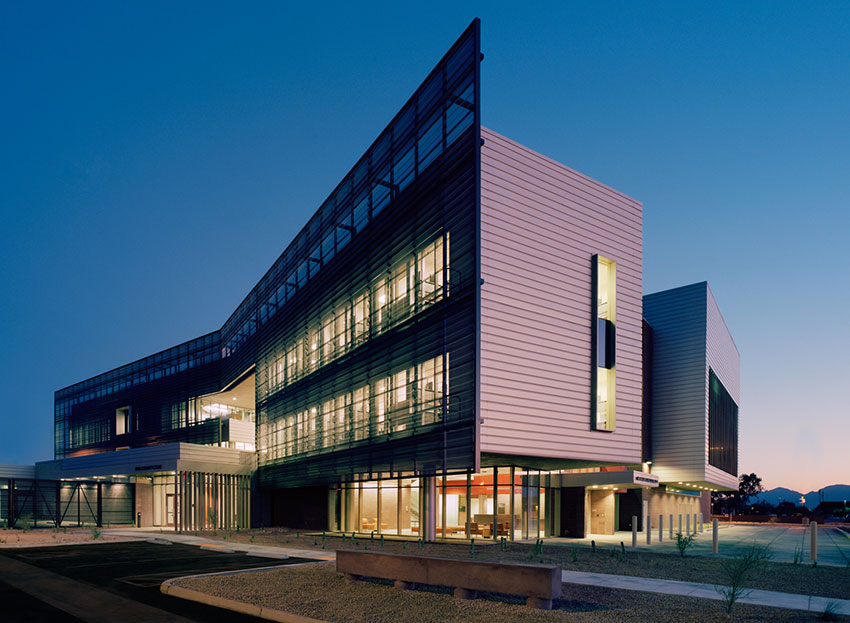
Photo courtesy of Kingspan Insulated Panels
Designers of the University of Arizona Medical Center South Campus building in Tucson, Arizona, chose IMPs to meet short construction deadlines, high design standards, and demanding environmental conditions.
Steel also sidesteps the waste associated with other types of construction, including wood construction, because it is cut to order and is infinitely recyclable. A key step to avoiding embodied carbon is reuse. Metal is the only known construction material that can be recycled indefinitely with little impact on material properties. This allows it to be repurposed in the same exact form, a process called closed-loop recycling. Not only are excess and scrap metals such as steel and aluminum readily and easily recyclable, it remains financially viable to recycle metal. This ensures that envisioned impact reductions actually will happen, instead of only existing “on paper.” Sixty to 80 million tons of steel scrap is recycled each year into new steel products in the U.S. alone.
“The excellent recyclability of steel is one of its strongest environmental attributes,” says Trisha Montalbo, senior consultant, thinkstep, Boston. “Additionally, with respect to carbon footprint and demand for nonrenewable energy resources, most of the metal wall assemblies were preferable to the concrete-based assemblies.”
Shop-fabricated metal components reduce onsite labor, cycle time, and construction waste. A 2,000-square-foot residence framed in steel produces less than 2 percent leftover material, all of which can be recycled, compared to wood framing, which yields an estimated 20 percent waste going to a landfill.
Product Transparency Certifications
When decision making to avoid embodied carbon and secure environmental benefits, look for IMP products that are supported with LCA documentation. Coupled with clear simple material ingredient reporting in the form of HPDs and Declare labels, EPDs and other LCA disclosures help in meeting LEED, WELL, and additional guidelines on many levels.
Environmental Product Declarations (EPDs) provide LCA-based information and details about the products’ environmental aspects and assist purchasers and users in making informed comparisons between products. IMP EPDs contain valuable information about product definition, building physics, the basic material and its origin, product manufacture and processing, in-use conditions, life-cycle assessment results, and testing results and verifications.
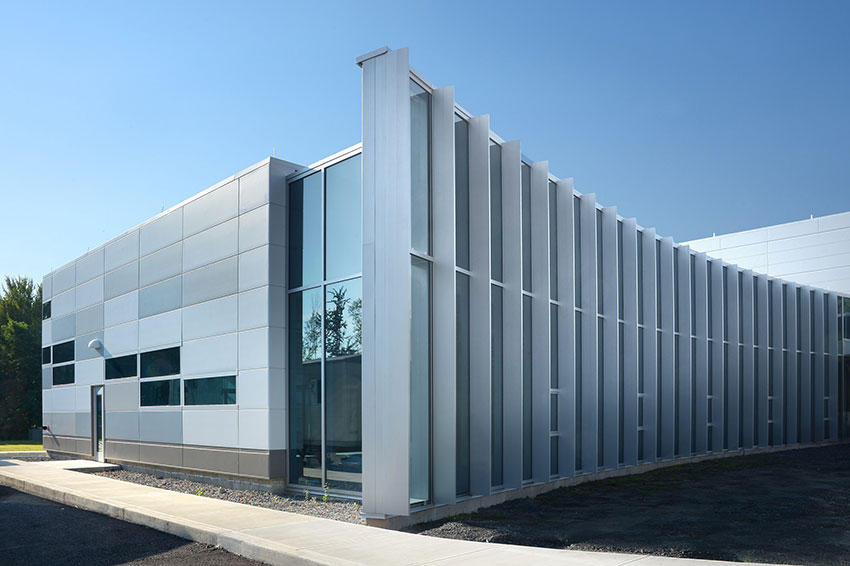
Photo courtesy of Metal Construction Association
Soraa, a leading developer of solid-state lighting, wanted a building to reflect their high-tech products. The building’s flat exterior incorporates over 22,000 square feet of IMPs in a blend of hues.
Achieving Sustainability Goals
IMPs also meet or exceed multiple sustainable design criteria that contribute toward a project earning green building certifications and push forward the design and construction of healthier and more environmentally conscious buildings.
Metal cladding components are factory coated with a 20-40 year warranted life coating, and any volatile compounds (VOCs) are controlled at the factory, not released at the jobsite. Daylighting and exterior views can also be easily incorporated into a metal building design to earn LEED credits using composite materials. Metal buildings offer effective insulation, reduced air leakage, and readily accept high-performance windows and doors. A metal roof can also be the ideal base to support solar panels. All of these factors can be used to earn LEED points.
Under LEED v4.1, IMPs are eligible for credits under the categories of Integrated Process, Sustainable Sites (SS), Energy & Atmosphere (EA), Materials & Resources (MR), Indoor Environmental Quality (EQ), Innovation (IN), and Regional Priority (RP).
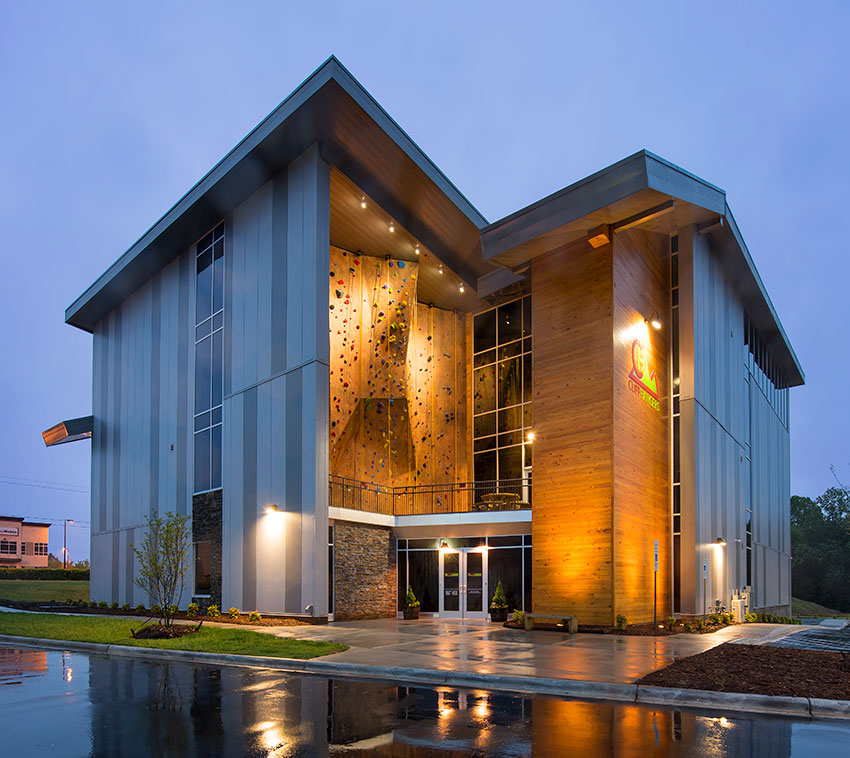
Photo courtesy of Nucor Insulated Panels Group
Architects of the Cliff Hangers facility in Mooresville, N.C., created an interest on the building facade by using the standard length of IMPs in only two colors. It is an eye-catching layout.
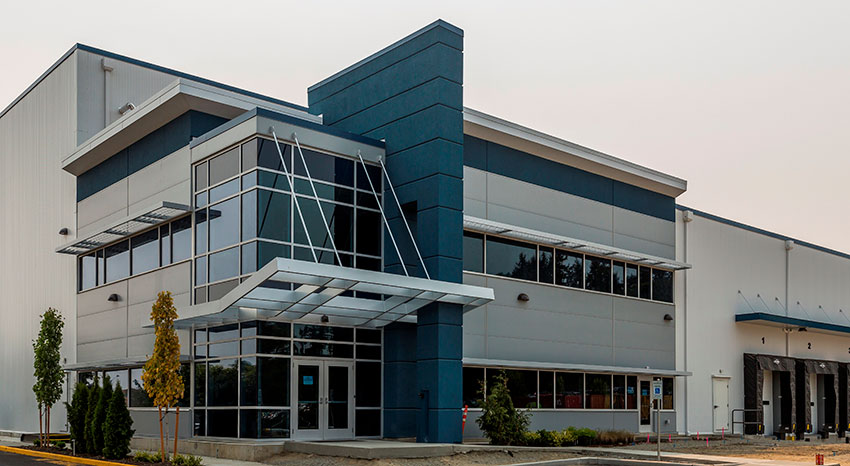
Photo courtesy of AWI Panels
Western Distribution Center in Seattle Washington is clad with insulated metal panels in striking colors.
Ready Integration with Solar Installations
IMPs act as a perfect host for solar installations. Combining solar installations with IMP wall or roof panels means enhancing overall system performance. IMPs are proven to reduce heating and cooling costs, provide the vapor, air, and water barrier beneath the installation, and can increase system ROI. IMP manufacturers offer easy integration with solar collection system, often resulting in significant cost savings.
Amanda Voss, MPP is an author, editor, and policy analyst. Writing for multiple publications, she has also served as the managing editor for Energy Design Update.




